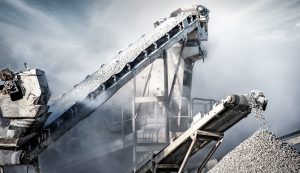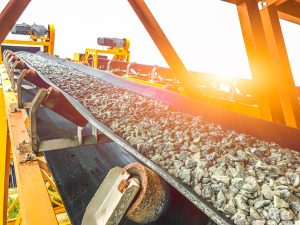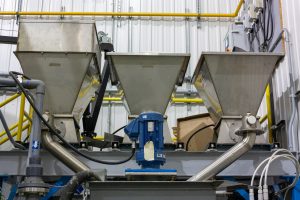5 Common Bulk Solids Handling Equipment
Comments Off on 5 Common Bulk Solids Handling Equipment
Bulk solids material handling equipment are used to store, move, and process raw materials and products. They speed up production and ensure that bulk materials can be handled in a safe and sanitary way.
The first bulk solids material handling equipment dates back to 1795: a primitive conveyor belt made of leather and a wooden bed that was used to transport grains and mining materials. Today, the equipment has become faster, more durable, and more precise. The latest automated systems even use machine learning and motion sensor technology and require very minimal human intervention.
Here are some of the most commonly used bulk solids material handling equipment that can be found in almost any processing facility that handles large volumes of material.
Hoppers and chutes
Hoppers and chutes are used to automatically feed material into the production line for further processing. They are usually connected to other bulk solids handling equipment such as conveyors, crushers, mixers, or dryers.
Hoppers are typically set up to allow a controlled feed rate, but material blocks can slow down the discharge or even stop it completely. That is why it is necessary to understand the material flow properties, select the right hopper angle and outlet size, and install a reliable flow aid like AirSweep.
Silos
Silos are used for storing bulk materials. These are typically used for food and agricultural products, but can also hold other bulk solids like cement materials, sawdust, woodchips, metal waste, and chemicals like carbon black and aluminum oxide.
The terms silos and hoppers are often used interchangeably, although there are distinct differences between these two bulk solids handling equipment. Watch this video on silos vs hoppers.
Conveyors
Conveyors are used to transport bulk materials or goods. Most conveyors still use the traditional belt design. Some applications use pulleys or buckets or have cleated surfaces to keep materials secure or evenly spaced.
When choosing the right conveyor (or any bulk solids handling equipment), users must consider the bulk material’s dimensions, weight, and fragility, as well as the plant environment like risk for corrosion and available space.
Conveyors and other bulk solids material handling equipment used for transporting materials such as bucket elevators will always have a risk for material spills. This typically occurs when one of the parts malfunction and cause the conveyor to run faster or slower than intended.
A DAZIC Zero Speed Switch can be installed into the conveyor or transport system to detect abnormal speeds and signal the operator before a spill occurs.
Stackers
Stackers are used to lift and stack heavy loads on warehouses and docks. Some warehouse automation systems combine stackers with autonomous shelf loader robots and shuttles, or systems that track inventory and coordinated routing. (Read our article on Top 5 Technologies for Automated Bulk Material Handling.)
Reclaimers
One of the largest bulk solids handling equipment, reclaimers are used to recover bulk materials from a stockpile. They typically consist of a bucket-wheel, counterweight boom, rocker, and a conveyor system.
Both stackers and reclaimers are used extensively in the mined minerals industry or other applications that have to gather raw materials from piles before redistributing them for shipment or processing.
Protect material flow in bulk solids handling equipment
Materials can often settle during storage, or develop flow problems during transportation and processing. AirSweep can help activate material to prevent material blocks or correct erratic flow.
AirSweep can be installed on any bulk solids handling equipment– silos, hoppers, conveyors, bucket elevators, or any vessel where material can hang up. Contact us to find out more about how to use AirSweep in your system.
The Hidden Cost of Poor Material Handling
Comments Off on The Hidden Cost of Poor Material Handling
Any industry that handles powder or bulk solids will experience a flow problem at some point in the process. However, poor material handling doesn’t just clog up a vessel, it can lower productivity, increase costs, and affect product quality.
Poor material handling costs accumulate across different aspects of production. Here’s a list of how material blocks or erratic flow can affect your bottom line.
Bottlenecks in production
Bridging and ratholing in one vessel can affect all downstream processes. In some cases, an entire line of machines needs to be shut down because a silo or hopper needs to be manually cleaned.
A paint company that was using titanium dioxide—a fine powder that is prone to bridging—was experiencing poor material flow in the live bin bottom feeder, collection hopper, the screw conveyor, and pneumatic transport vessel. Each time the material moved to another stage of production, the material would clog up. It took over 50 minutes just to transport one batch over 325 feet.
AirSweep completely resolved the poor material handling issues and cut batch time to just 15 minutes, dramatically improving productivity.
Idle machine time
Every hour of machine downtime means lost productivity. A cement company even calculated their loss at $12,000 for every hour of downtime—not including the manpower hours they lost while their workers hammered at the silos.
Poor material handling is expensive. After installing AirSweep, their productivity increased and they also saved more on energy, because the system used less energy and air than the other flow aids they had tried.
Spoiled material
A commercial bakery had issues with flax and cocoa bridging above the discharge and caking on the walls and filter bags. This led to numerous delays and expensive wastage. They had to throw away up to 40 pounds of mixture a day and even had to pay to have it hauled away.
AirSweep solved 90% of their poor material handling problems. Aside from reducing wastage and improving production speed, they no longer need to climb equipment to dismantle and clean the ingredient receiver.
Cost of Maintenance
Choosing the wrong flow aid can lead to poor material handling. You need to consider the material flow properties, and both the capacity and cost of using a flow aid.
Fluidizers can only activate light powders and have a small activation radius. So, you will need to install several units to achieve material flow. Aside from this, fluidizers have to run continuously, which can be very expensive in countries that have high electricity costs.
Vibrators can cause some materials to become compact, and cannot completely remove residue on vessel walls. They also consume a lot of electricity and cause metal fatigue that can damage vessels.
In contrast, AirSweep is effective and energy efficient. It is used by thousands of plants around the world to guarantee on-demand flow of even the toughest materials: powders, moist and sticky compounds, heavy solids, or even irregular particles that have a tendency to segregate.
Though it taps the same level of air pressure as fluidizers, air vibrators, and other similar equipment, the AirSweep system does not run continuously. It starts and stops with the discharge cycle, and runs in a sequence with one pulse at a time. So overall, it uses less compressed air than a flow aid that runs continuously.
By increasing production and lowering maintenance and operating costs, AirSweep can actually pay for itself after just a few weeks.
Solve poor material handling with AirSweep
The AirSweep system leads to better flow, higher productivity, and lower costs. Contact us to find out how we can improve your process, and your profits.
The Importance of a Conveyor Belt Speed Sensor in Production Facilities
Comments Off on The Importance of a Conveyor Belt Speed Sensor in Production Facilities
People use many safety devices in their homes to protect their safety and prolong the life of their appliances: fire alarms, burglar alarms, voltage regulators, and circuit breakers.
But many production facilities simply assume that material spills won’t happen, or its hazards or costs. What if a conveyor belt suddenly fails and causes tons of material to spill to the ground? Could someone get hurt? How long would it take to clear everything and restart production?
DAZIC saves the day
DAZIC Zero Speed Switches are “smart switches” that shut off any equipment if they run outside of the normal speed limits. They can be installed on conveyor belts, mixers, bucket elevators, or any machine with a rotary device.
Barnes & Co, a concrete manufacturer based in the US, has relied on its conveyor belt speed sensor to prevent a ton of problems. Their feeders load up to 250 tons of gravel per hour. Any equipment malfunction could lead to an avalanche of material. “It’s really a safety issue,” said plant supervisor Joe Kruzewski. “It would be a train wreck [to be] buried with that amount of gravel.”
Kruzewski estimates that it would take three people at least three hours to shovel one ton of gravel. Even just a 10-minute delay could result in 30 hours of downtime. “We would have to shovel for days!”
But they never had this problem, because of the DAZIC conveyor belt speed sensor they installed on all of their 12 conveyors years ago. “It would be a nightmare if the DAZIC didn’t shut the conveyor belt down. I don’t even want to think about it,” Kruzewski said.
Benefits of a speed sensor
Barnes & Co. invested in a conveyor belt speed sensor because it was a form of “insurance” against many bigger and more expensive problems. As a family business, they need to maximize their production and avoid the backlash of a safety violation or a worker injury.
DAZIC Zero Speed Switches protect the plant, the process, and the people.
- Improved safety. A zero speed switch can detect when a machine has stopped rotating and can shut off the power quickly, reducing the risk of accidents and injuries.
- Reduced downtime. Zero speed switches can detect when a machine has stopped and alert operators to the problem so they can take corrective action quickly, reducing downtime
- Increased efficiency. By detecting when a machine has stopped, a zero speed switch can help optimize production processes and increase overall efficiency.
- Improved maintenance. A zero speed switch can detect when a machine has stopped and alert operators to the problem, allowing for quick preventive maintenance and avoiding costly repairs or replacements.
Affordable, durable, and effective
Compared to other equipment, DAZIC Zero Speed Switches are less expensive and require very little maintenance and replacement.
One of the world’s biggest manufacturers of sustainable, fiber-based products had been using Control Concepts’ DAZIC since the early 2000s.
In 2006, the company installed DAZIC 8100 switches on its conveyor belts. Years passed, plant managers changed, equipment changed, and the DAZIC switches kept on running. The switches worked so well that people forgot they were even there.
In 2019, the fiber-based manufacturer changed its conveyor belts but did not check the DAZIC speed switch. Months passed before a sludge build-up was noticed. It wasn’t enough to stop operations, but as a precaution, the company sent their conveyor belt speed sensor to Control Concepts to have it checked.
Control Concepts cleaned the item and investigated the problem further. Apparently, over the years, the new conveyor belts had a quick start-up design that was beyond the DAZIC product specifications.
The wear and tear from carrying a load beyond its specs could have caused the leaks. Despite this, the 15-year-old switch was still working—just dirty.
After learning why the conveyor belt speed sensor failed, the client was impressed by DAZIC’s durability and the team’s commitment to finding the cause of the problem and working on a better solution. “We have used DAZIC in many of our plants for nearly two decades. It is a brand and a company you can trust.”
Protect your process with a speed sensor
Contact us to find out more about DAZIC and how it can protect your production facility’s safety and productivity.
AirSweep vs Pneumatic Knocker
Comments Off on AirSweep vs Pneumatic Knocker
The oldest flow aid in the world is the hammer. People would hit their storage vessels to dislodge stuck material. It wasn’t very effective (or sanitary) because there would always be a little material left.
A pneumatic knocker is essentially an automated hammer. Compressed air pushes a piston against the vessel wall. But even if a pneumatic knocker automates the process, it doesn’t solve the problem. You will still have material residue, and you’re not guaranteed first in/first out flow.
The problem with hammers
Even if a pneumatic knocker uses air, its working principle is closer to an industrial vibrator rather than other pneumatic flow aids like AirSweep and fluidizers. In fact, it is often used in wet environments that would make an electric vibrator difficult.
But hitting vessels—whether it’s with a $10 hammer or an expensive pneumatic knocker system—will always cause more problems than it solves.
- Leftover material residue. Moist and sticky material will still cling to vessel walls. This can cause material spoilage and contamination, and affect batch consistency. Workers still have to periodic manual cleaning to completely flush out the material.
- Damage to vessels. The vibrations cause metal fatigue, which can damage thin vessels and lead to higher long-term maintenance costs.
- High noise levels. While not as loud as an air cannon, the sound of several pneumatic knockers banging on the vessel can stress out workers and may even cause deafness.
What a pneumatic knocker can (and can’t) do
A pneumatic knocker is effective for shaking off excess fine powder or water and releasing products from molds. It may also have very specific uses like preventing the adhesion of workpieces in a furnace.
However, if you’re looking for on-demand material flow, you need the true pneumatic flow aid—AirSweep.
AirSweep vs Pneumatic Knocker
AirSweep uses powerful air pulses that break up material blocks, pushes material back into the flow stream, and flushes the walls completely clean.
- Effective for all materials. A pneumatic knocker can only activate water and fine powders. AirSweep can move even moist powders, sticky compounds, or heavy bulk solids.
- No damage to the vessels. AirSweep can even be installed on very thin or small vessels—that’s how safe it is.
- No noise. The air pulses are just like a gentle hiss, and the sound is further muffled by the material in the vessel.
- Lower operating costs. AirSweep uses less plant air and energy than the air knocker, vibrator, or air cannon. It is the most energy-efficient flow aid you can find.
Drop the hammers
A food manufacturing company found that AirSweep was a more effective (and much quieter) alternative to hammers.
Bunge is an agribusiness and food ingredient company based in the USA. Rice bran was clumping in their hoppers and silos—a common issue for materials that hold moisture and are sensitive to humid environments. Workers had to hammer the vessels, which was ineffective and stressful for everyone in the factory. “It was like fingernails on the chalkboard. You wanted to get away from it,” said John Pappenheim, Bunge’s Maintenance Manager.
AirSweep instantly solved all material blocks. They had no clumping issues, no dents on machines, and no irritating hammering noises. The results prompted the company to install another system in their masa flour factory.
While Bunge used “traditional” hammers, this case study shows that hitting a vessel will not promote material flow—even if it is automated. AirSweep doesn’t just shake a vessel, it sweeps material into the flow stream.
Visit the AirSweep page to find out more about its features and what it can do for your process.
How Does AirSweep Improve Material Handling Efficiency?
Comments Off on How Does AirSweep Improve Material Handling Efficiency?
The biggest challenge of any factory or plant is material handling efficiency. How can you move massive amounts of material and prevent spoilage and waste? How do you get material to flow properly when it’s mixed and processed? How can you prevent material blocks that can stop production?
The reason material handling efficiency is so difficult is that materials have different flow properties. Some will settle during storage, or segregate when they’re mixed. Others will attract moisture and clump or cake. The sticky and dense formulas also have a tendency to cling to vessel walls and pipes.
Cohesive powders and solutions also present another problem: bridging and ratholing. Once these form in a vessel, the material flow slows down and even stops completely.
AirSweep improves material handling efficiency
Thousands of plants around the world trust AirSweep to solve these problems. AirSweep is a pneumatic flow aid that uses powerful air pulses to break up material blocks and push them back into the flow stream. It’s proven effective for even tough materials that other flow aids can’t handle.
Speed up production
Sluggish material flow affects all downstream processes and increases total production time. In many cases, workers even have to be pulled from other parts of the plant to manually clear the blocks.
Installing AirSweep can significantly speed up production. A minerals processing plant handles 120,000 tons of material a year. However, the powders and pebbles would plug the outlets. It took them an hour to fill just one supersack.
With AirSweep in place, material flowed quickly and reliably—cutting the filling of supersacks from one hour to two minutes. That’s a 3000% increase in production! The company eventually hired more people to keep up with the higher material flow.
Enable product innovation
Companies are always trying to improve their product. However, changing any component in a product formula can introduce new problems in material handling efficiency.
An international paint company needed to use a new grade of titanium dioxide. However, the material, which had finer and lighter particles, had a tendency to bridge above the feeder system and on the pneumatic transport vessels.
When AirSweep was installed in those problematic areas, it was able to clear out blocks and ensure on-demand flow. This reduced the batch time to just 15 minutes.
Reduce material waste
Food industries have to meet very strict regulations on spoilage and contamination. So, poor material flow will often mean throwing away any compromised batches. In fact, a flax company had to toss out 40 pounds of mixture away a day and even have to pay to have it hauled away.
The company tried many flow aids, including vibrators and fluidizers. However, workers still ended up spending an hour each day clearing away clogged material. Poor material handling efficiency was wasting money and time.
After AirSweep, everything changed. The system solved 90% of the material retention problems, reduced waste, and improved production speed.
Ensure plant safety
Safety violations and risks can cost a business its license to operate and lead to thousands of dollars in fines. However, poor material flow can put workers at risk, especially if they have to manually clean out stuck material in a hazardous environment.
One of the world’s largest building materials companies had issues with hot cement clinker plugging up vessels and chutes. Workers had to break up the material with bars and hammers, but this unnecessarily exposed them to chemicals and dust.
After installing AirSweep, they never had issues with clogged clinker. It improved production, but more importantly, ensured the safety of the workers.
AirSweep is proven to improve material handling efficiency
AirSweep is used in every industry and in every continent except Antarctica. Go to our case studies page to find more stories of how it has helped companies increase production, reduce waste, lower cost, and improve product quality and plant safety.
How to Choose the Right Flow Aid for Your Material
Comments Off on How to Choose the Right Flow Aid for Your Material
Flow aids can help clear material bridging in hoppers or any other storage bin, chute, or conveyor. They are relatively inexpensive, and can actually “pay for themselves” because of the increase in productivity.
It’s important to get the right flow aid for your material. The wrong flow aid may not be able to activate the material, or may even cause material blocks to compress even further. Some flow aids also create other problems, like high energy costs or damage to the vessel.
Here is a simple guide to the different flow aids, so you can pick the best one to clear material bridging in a hopper.
Industrial Vibrators
Industrial vibrators use mechanical agitation to improve material flow. The movement breaks a material’s cohesive friction and loosens it from vessel walls. They are sometimes called vibrating dischargers or agitators.
However, vibrators are not very efficient. They can make some materials settle or become compact—think of how you shake the measuring cup to condense brown sugar. That’s fine if you want to bake cookies, but not if you’re trying to achieve material flow in your plant.
That’s what happened to Flax4Life, a commercial bakery that produces gluten-free muffins, brownies, and other baked goods. “The vibrators that came installed on the bottom of the hopper above the mixture practically turned the flax into concrete,” said Stanley Rhea, the maintenance department head.
Vibrators can also still leave residue on vessel walls, which means you still need to do manual cleaning between batch runs. That wastes time and even increases costs. A spice company spent an average of $200,000 just on flushing material for their ribbon blenders.
Finally, industrial vibrators consume a lot of energy, are very noisy, and can cause metal fatigue.
Fluidizers
Fluidizers use a combination of aeration and gentle vibration to activate the material. While these are one of the most inexpensive flow aids (sometimes, they come pre-fitted into storage vessels) they are only effective for light powders like flour.
Fluidizers also have a very small activation radius, so you may need dozens of them to correct material bridging in a hopper. Since the units run continuously, you will have higher energy costs. So, even if it is “cheap” it is not cost-efficient, and you may end up spending more in the long run.
Air cannons
Air cannons release a high-pressure blast of air (typically compressed to 100 PSI) to disperse material.
While air cannons seem powerful, it actually provides limited results. Air tends to “channel” through holes in the material, greatly diminishing effectiveness. It also leaves material residue on the walls and often has “blind spots” where material can still collect. You also cannot control the feed rates.
Air cannons also cause a lot of metal fatigue, and will actually cause damage to the vessels. The loud blasts of noise can also be very stressful for workers, and long term, can cause hearing problems.
AirSweep
AirSweep is a pneumatic flow aid that uses short, powerful pulses to push material back into the flow stream. It can activate any kind of material—even moist, sticky, and heavy powders and solids. It even works on liquid cheese.
Watch this video to see how AirSweep is the most effective solution to material bridging in hoppers:
Many companies switched to AirSweep simply because it worked better than any other flow aid. Flax4Life tried vibrators and fluidizers, and neither of them worked. “AirSweep got a 10/10!” said Stanley Rhea.
Heidelberg Cement, one of the largest building materials companies in the world, also found that AirSweep was more effective than air cannons. “AirSweep worked perfectly!”
Get the right flow aid for your material
We can customize the AirSweep system for your process. We have different models with various activation ranges and a USDA-accepted model for sanitary processes. Our AirSweep Straight Shooter can also release a vertical column of air for chutes or hard-to-reach areas.
Get a free proposal today, and finally solve material bridging in hoppers for good.




